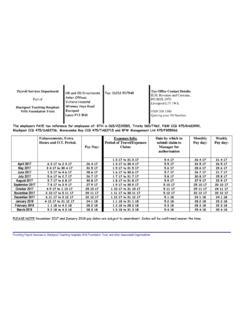Transcription of Leadership Styles Daniel Goleman et al
1 Leadership Styles Daniel Goleman et al Daniel Goleman - a leading authority on emotional intelligence has identified six effective Leadership Styles : Pacesetting Do it my way Commanding1 Do it because I say so ----- Visionary2 Let s remind ourselves of the larger purpose Affiliative People first, task second Democratic Let s work it out together Coaching Let me help you develop These Leadership Styles amongst other aspects are contained within his excellent book, The New Leaders3. Typically, the best, most effective leaders act according to one or more of six distinct approaches to Leadership and skilfully switch between the various Styles depending on the situation.
2 Four of the six Styles visionary, coaching, affiliative and democratic create the kind of resonance that boosts performance. Two others pacesetting and commanding [..] should be applied with caution .4 Two documents for each style are attached: A broader explanation of when it s appropriate to adopt this style A training guide to increasing your skills in this area. When you ve read the Styles , consider: which ones you would use most frequently if you were your ideal self which ones you use most frequently today what it would take to shift you towards your ideal self 1 Goleman uses three different names for this style: directive, coercive and commanding.
3 2 Goleman uses at least two names for this style: authoritative and visionary. 3 The New Leaders. Goleman , Boyatzis and MCKee. ISBN 0-7515-3381-5. 4 The New Leaders. Goleman , Boyatzis and MCKee. ISBN 0-7515-3381-5. Page 67. Part I The Dissonant Styles . Apply with Caution. 1. Pacesetting Style Do it my way Primary objective: Accomplishing tasks to high standards of excellence. A leader using this style: Holds and exemplifies high standards for performance. Is obsessive about doing things faster and better. Asks others to do things to a high standard; and do them faster / better.
4 Pinpoints poor performers, demands more from them. Rescues the situation if others don t perform, by assuming responsibility for the task or giving detailed instruction on how to do it . Has little sympathy for poor performance. Seeks co-ordination with others only if it has an impact on an immediate task. Sees development of others as showing them how to do it . The Pacesetting Style is most effective when individuals are: Highly motivated, competent and know their jobs. Need little direction or co-ordination. Individual contributors, scientists Quick results are required, in a sink or swim situation.
5 Similar to their managers (and the organisation needs more of the same). The Pacesetting Style is least effective when: The leader can no longer do all his / her own work personally. Individuals need or want vision, personal development and / or co-ordination amongst themselves or others. Employees seek a trusting / empowering relationship where they can influence how they deliver the objectives. Employees are looking for some sense that the leader is interested in them as an individual not as a means to getting things done.
6 Summary When used effectively the Pacesetting Style works for individuals who are completely self-motivated and understand their objectives. The style is less effective in times of change when an explicit discussion around the mission and role of each individual is required. It can also make extreme demands on the leader as s/he takes on more and more of the tasks of his / her direct reports. To increase the Pacesetting Style, try the following: Maintain and develop your technical / professional expertise. Teach by example and model the behaviour you wish to see, first into work, last out.
7 When employees need assistance, tell them or show them how you would handle the situation. Anticipate all potential obstacles and how to overcome them; and explain to them what you would do in those situations. Insist on excellence, don t accept mediocrity. Delegate only those tasks about which you feel comfortable s/he can handle. If the outcome is critical, add some back-up support. Emphasise results. Tell your employees that you ll leave them alone if they get the results you re seeking, otherwise you ll be following up regularly.
8 To turn down the Pacesetting Style, try the following: Ask yourself how it feels to be led by you. Ask others who are led by you. Listen to their answers. Ask yourself how you wish to be led. How does the Pacesetting Style fit with your answer(s)? Resist the urge to answer any question with THE answer. Ask a question instead, what are you minded to do about this? How do you see your options? Keep an open mind about THE answer. Maybe there is more than one answer. Offer support that doesn t include giving them THE answer, how can I help you go forward with this issue?
9 Let go of the idea that you are the only one who can do things properly around here. Instead ask yourself how you are contributing to this perceived situation. Learn to listen properly, be fully present not just waiting for them to finish speaking so that you can speak. 2. Commanding Style Do it because I say so Primary Objective: Immediate compliance. A leader using this style: Gives lots of directives by telling people what to do. Rarely seeks any input from the individual. Controls tightly through constant monitoring.
10 Relies on negative, corrective feedback to emphasise what is wrong and achieve compliance. Motivates others by emphasising the consequences of getting it wrong. Can be closed to other Styles of working; and may ridicule them as soft . The Commanding Style is most effective when: Dealing with relatively straightforward tasks. In crisis situations when individuals need clear direction and the leader has more information than the individuals concerned, in a hostile takeover situation or serious emergency. When deviations will result in serious consequences, safe and healthy issues.
















